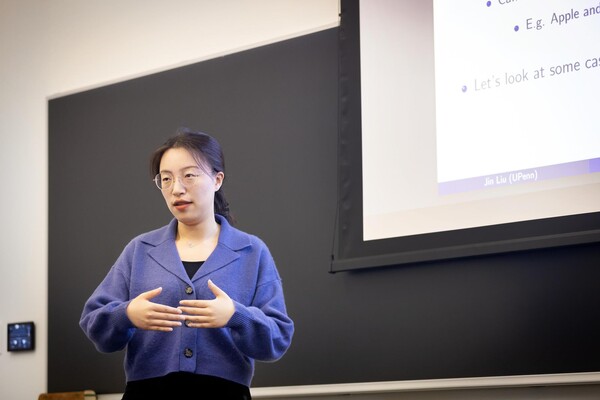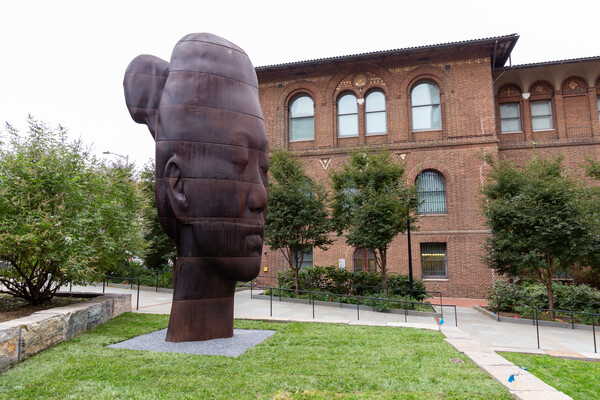
(From left) Doctoral student Hannah Yamagata, research assistant professor Kushol Gupta, and postdoctoral fellow Marshall Padilla holding 3D-printed models of nanoparticles.
(Image: Bella Ciervo)

Apical periodontitis, a chronic and hard-to-treat dental infection, affects more than half of the population worldwide and is the leading cause of tooth loss. Root canal is the standard treatment, but existing approaches to treat the infection have many limitations that can cause complications, leading to treatment failure.
Now, researchers at the School of Dental Medicine, Perelman School of Medicine, and School of Engineering and Applied Sciences have identified a promising new therapeutic option that could potentially disrupt current treatments. The team of researchers is part of the Center for Innovation & Precision Dentistry, a joint research center between Penn Dental Medicine and Penn Engineering that leverages engineering and computational approaches to advance oral and craniofacial healthcare innovation.
In a paper published in the Journal of Clinical Investigation, they show that ferumoxytol, an FDA-approved iron oxide nanoparticle formulation, greatly reduces infection in patients diagnosed with apical periodontitis.
“This is the first study showing the clinical efficacy of a nanotherapy in the treatment of a severe chronic biofilm infection,” says Hyun (Michel) Koo of Penn Dental Medicine. “We previously found that ferumoxytol effectively inhibits pathogenic biofilms in the human mouth, so we asked if these same nanoparticles could treat an even more challenging biofilm: those hidden inside the root canal.”
Biofilms are dense, sticky communities of bacteria that attach to surfaces and cause recalcitrant infections. A protective matrix and the antimicrobial resistance of microbes residing in them make biofilms (like dental plaque) difficult to treat. However, when they form deep in the tooth root canal, they pose an even greater challenge.
The small size and antimicrobial efficacy of nanoparticles make them excellent candidates for treating biofilms, and the researchers were able to demonstrate that topical applications of ferumoxytol in combination with hydrogen peroxide (H2O2) potently disrupt biofilms in multiple experimental models.
“Ferumoxytol nanozymes—because of their unique catalytic (enzyme-like) activity—offer new and very effective ways to treat biofilm infections,” says David Cormode of Penn Medicine and Penn Engineering.
“They represent an exciting new type of therapeutic agent, since they exhibit novel therapeutic effects while being low-cost and shelf stable.”
Currently, sodium hypochlorite (NaOCl) is the gold standard disinfection solution used during root canals; however, it can cause complications if not contained to the treatment area, explains Bekir Karabucak of Penn Dental Medicine.
“Effective root canal disinfection is essential for treatment success. However, targeting microbes while preserving tooth structure is challenging. Current procedures require mechanical methods and harsh disinfectants to eliminate biofilm infection, but if not applied carefully, these solutions can harm surrounding tissues” says Karabucak.
The researchers treated 44 patients with periapical periodontitis with either ferumoxytol/H2O2, saline, or NaOCl after they underwent standard endodontic surgical procedures; bacterial samples were taken before and after treatment. They found that patients who received ferumoxytol/H2O2 achieved a 99.9% reduction in bacterial counts without experiencing any adverse effects, demonstrating that this treatment to be a safer and effective alternative to NaOCl.
As part of their process, they found an unexpected result: nanozymes had a positive effect on a population of stem cells found at the tip of the developing tooth root, stimulating their growth and activating them to produce bone—a property known as osteogenic capacity.
“What started as a simple inquiry into potential toxicity evolved into something revolutionary: a treatment capable of eliminating stubborn biofilms while simultaneously regenerating tissue for healing, which is a novel concept for tissue regeneration through activation of one’s own tissue’s stem cells,” says Chider Chen of Penn Dental Medicine.
This finding paves the way for investigating the use of ferumoxytol nanozymes in vital pulp therapy, a viable alternative in the early stages of disease that prevents patients from going through root canal treatment.
“Enhancing the success of vital pulp therapy with affordable, effective biomaterials can lower dental care costs. More importantly, it helps patients preserve their natural tooth structure and lifelong chewing function,” says Karabucak.
Nanozymes may also be a promising approach for repairing craniofacial bone defects and treating other bone-related diseases such as osteoporosis, periodontitis, and autoimmune-induced osteopenia, given their ability to promote bone growth.
Koo is excited about the possibilities.
“Iron oxide nanozymes may be a transformative new class of therapeutics that provides both antibiofilm and tissue regenerative properties, offering a regenerative approach to antimicrobial therapy,” he says. “The options are limitless: it is biocompatible, inexpensive to manufacture, and can be incorporated in a variety of formulations. We are expanding nanozyme use in other aspects of oral health care.”
Hyun (Michel) Koo is a professor in the Department of Orthodontics and Divisions of Pediatrics and Community Oral Health in the School of Dental Medicine and in the Department of Bioengineering in the School of Engineering and Applied Science and the co-founder of the Center for Innovation & Precision Dentistry at the University of Pennsylvania.
Bekir Karabucak is a professor and chair of the Department of Endodontics in Penn Dental Medicine.
Chider Chen is an assistant professor in the Department of Oral and Maxillofacial Surgery/Pharmacology in Penn Dental Medicine.
David Cormode is a professor of radiology and bioengineering with appointments in the Perelman School of Medicine and School of Engineering and Applied Science at Penn.
Other authors are Alaa Babeer, Ranran Huang, Yuan Liu, Min Jun Oh, Nil Kanatha Pandey, Zhi Ren, Aurea Simon-Soro, and Zhenting Xiang of the School of Dental Medicine at the University of Pennsylvania.
The work was supported in part by funds from the National Institute of Dental and Craniofacial Research (NIDCR) (R01DE025848 and NIDCR R21DE033128) and the Department of Endodontics Research Fund, University of Pennsylvania. ZR was supported by the NIDCR Postdoctoral Training Program (R90DE031532).

(From left) Doctoral student Hannah Yamagata, research assistant professor Kushol Gupta, and postdoctoral fellow Marshall Padilla holding 3D-printed models of nanoparticles.
(Image: Bella Ciervo)

Jin Liu, Penn’s newest economics faculty member, specializes in international trade.
nocred

nocred

nocred